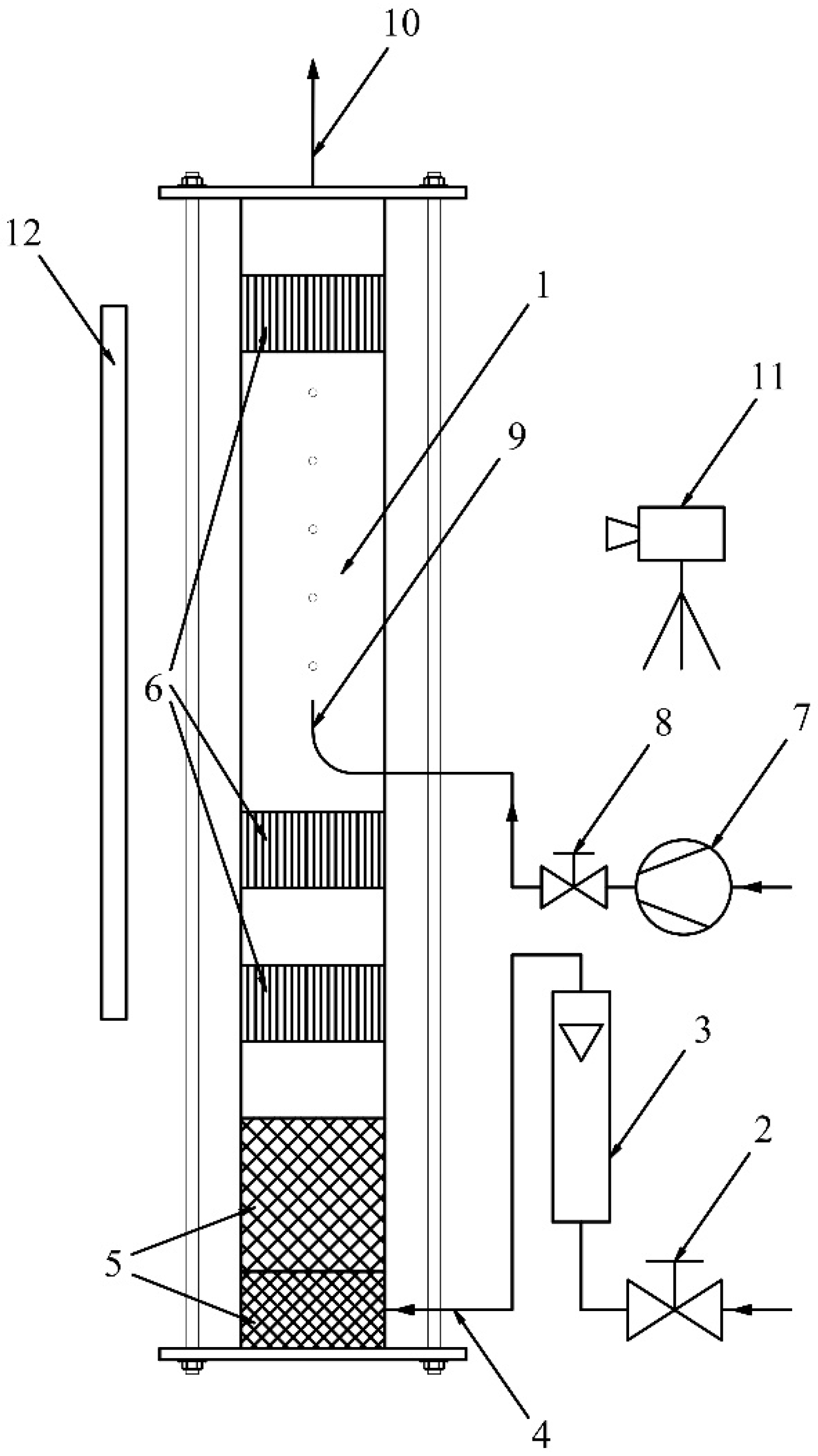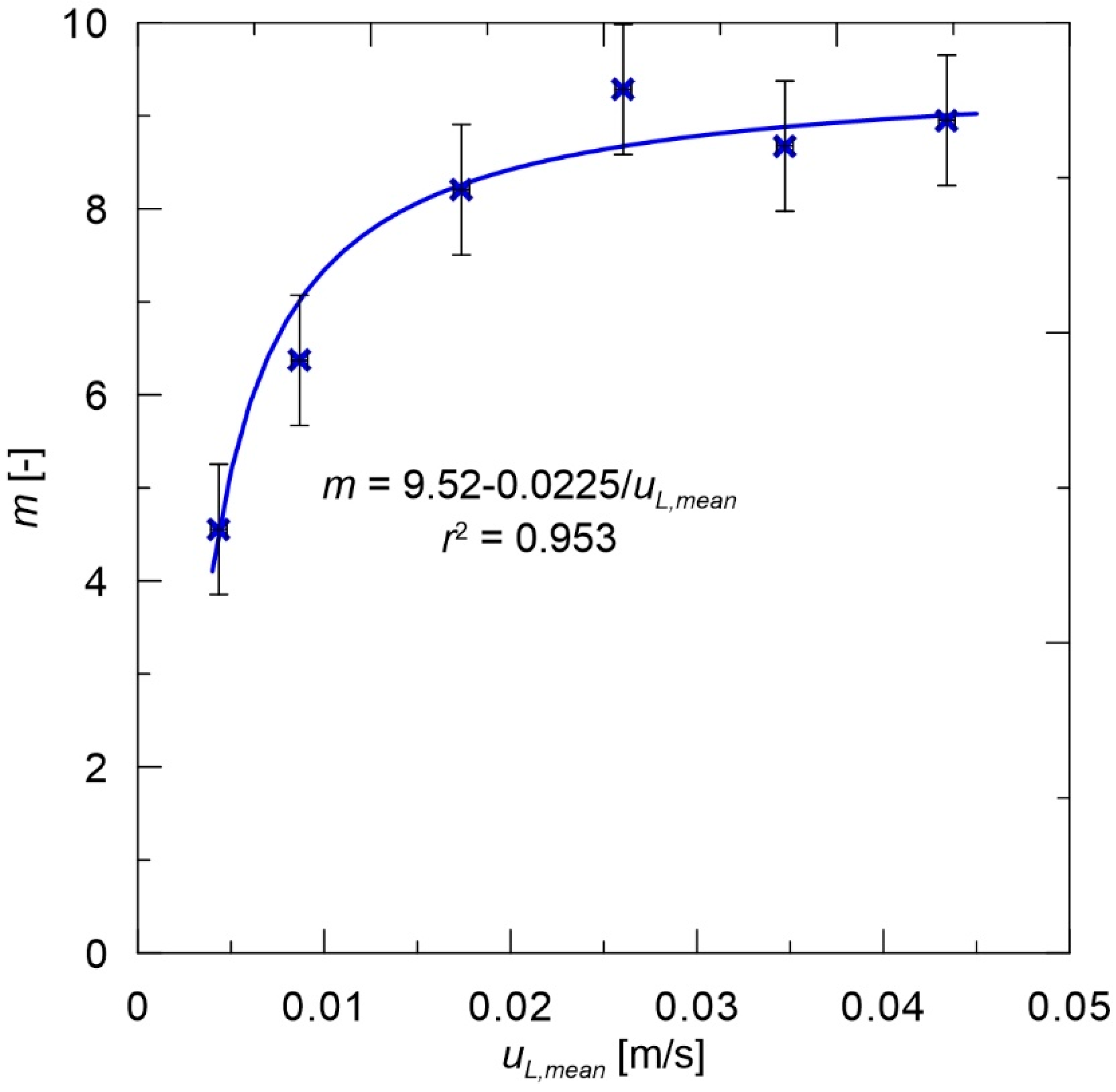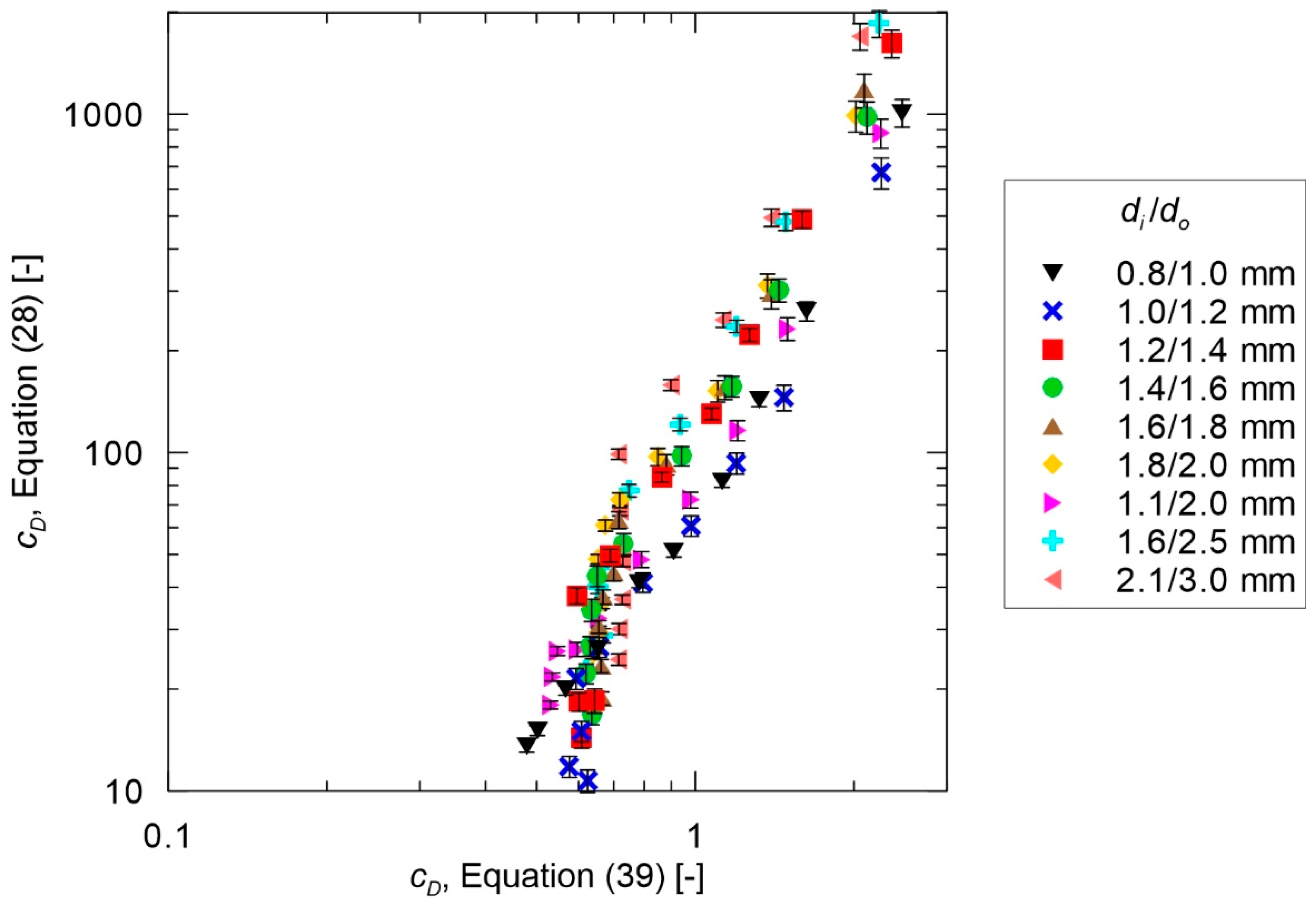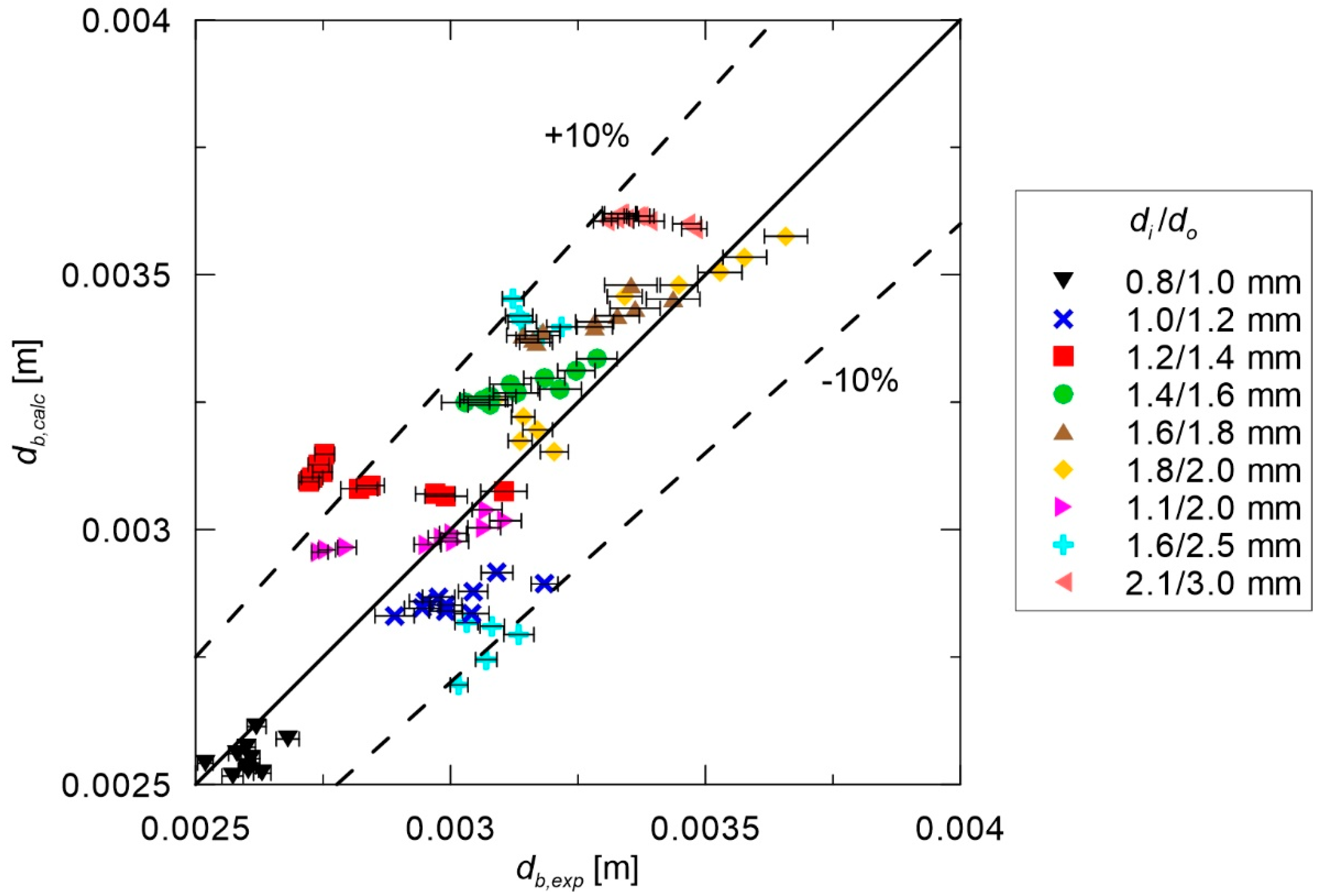Determination of a Bubble Drag Coefficient during the Formation of Single Gas Bubble in Upward Coflowing Liquid
Abstract
:1. Introduction
- —bubble diameter, m
- —gravitational acceleration, m/s2
- —liquid density, kg/m3
- —gas density, kg/m3
- —inner nozzle diameter, m
- —liquid surface tension, N/m
- —gas volumetric flow rate, m3/s
- —bubble detachment frequency, Hz
- —drag coefficient, -
- —area of influence of drag force, m2
- —liquid velocity, m/s
- —displacement of the center of mass of the bubble, m
- —time, s
- —mass, kg
- —gas volumetric flow rate, m3/s
- —volume, m3
- —modified Froude number (Sada et al. [22]), -
- —gas velocity, m/s
- —superficial liquid velocity, m/s
- —Bond number,
- —Froude number,
2. Materials and Methods
2.1. Materials
2.2. Experimental Setup
2.3. Experimental Procedures
2.4. Model Formulation
- —local liquid velocity at the point , m/s
- —mean liquid velocity in the column, m/s
- —coefficient depending on the velocity profile shape, -
- —column width, m
- , —location coordinates in the column cross-section relative to the column axis, m
3. Results
3.1. Velocity Profile
3.2. Drag Coefficient
3.3. Comparison with Drag Coefficient Calculated Using the Equation for Bubble Rising
3.4. Validation of Experimental Drag Coefficient Correlation
4. Discussion
Author Contributions
Funding
Conflicts of Interest
Nomenclature
| Symbols: | |
| area of influence of drag force, m2 | |
| , | coefficients, - |
| Bond number, - | |
| drag coefficient, - | |
| conversion factor for conversion diameter in pixels to meters, m/pixel | |
| bubble diameter, m | |
| horizontal bubble diameter, m | |
| inner nozzle diameter, m | |
| outer nozzle diameter, m | |
| bubble detachment frequency, Hz | |
| Froude number, - | |
| modified Froude number (Sada et al. [22]), - | |
| gravitational acceleration, m/s2 | |
| column width, m | |
| mass, kg | |
| coefficient depending on the velocity profile shape, - | |
| gas volumetric flow rate, m3/s | |
| Reynolds number, - | |
| bubble projection surface, pixels | |
| displacement of the center of mass of the bubble, m | |
| time, s | |
| superficial liquid velocity, m/s | |
| gas velocity, m/s | |
| liquid velocity, m/s | |
| mean liquid velocity in the column, m/s | |
| tracer settling velocity, m/s | |
| volume, m3 | |
| , | location coordinates in the column cross-section relative to the column axis, m |
| Greek Symbols: | |
| liquid dynamic viscosity coefficient, Pa·s | |
| gas density, kg/m3 | |
| liquid density, kg/m3 | |
| liquid surface tension, N/m | |
References
- Brennen, C.E.; Brennen, C.E. Fundamentals of Multiphase Flow; Cambridge University Press: New York, NY, USA, 2005. [Google Scholar]
- Curds, C.R. The ecology and role of protozoa in aerobic sewage treatment processes. Ann. Rev. Microbiol. 1982, 36, 27–28. [Google Scholar] [CrossRef]
- Pronk, M.; De Kreuk, M.K.; De Bruin, B.; Kamminga, P.; Kleerebezem, R.V.; Van Loosdrecht, M.C.M. Full scale performance of the aerobic granular sludge process for sewage treatment. Water Res. 2015, 84, 207–217. [Google Scholar] [CrossRef]
- Hasan, M.N.; Khan, A.A.; Ahmad, S.; Lew, B. Anaerobic and aerobic sewage treatment plants in Northern India: Two years intensive evaluation and perspectives. Environ. Technol. Innov. 2019, 15, 100396. [Google Scholar] [CrossRef]
- Besagni, G.; Inzoli, F.; Ziegenhein, T. Two-phase bubble columns: A comprehensive review. ChemEngineering 2018, 2, 13. [Google Scholar] [CrossRef] [Green Version]
- Merchuk, J.C. Airlift bioreactors: Review of recent advances. Can. J. Chem. Eng. 2003, 81, 324–337. [Google Scholar] [CrossRef]
- Prończuk, M.; Bizon, K.; Grzywacz, R. Experimental investigations of hydrodynamic characteristics of a hybrid fluidized bed airlift reactor with external liquid circulation. Chem. Eng. Res. Des. 2017, 126, 188–198. [Google Scholar] [CrossRef]
- Prończuk, M.; Bizon, K. Investigation of the liquid mixing characteristic of an external-loop hybrid fluidized-bed airlift reactor. Chem. Eng. Sci. 2019, 210, 115231. [Google Scholar] [CrossRef]
- Kulkarni, A.A.; Joshi, J.B. Bubble Formation and bubble rise velocity in gas-liquid systems: A review. Ind. Eng. Chem. Res. 2005, 44, 5873–5931. [Google Scholar] [CrossRef]
- Clift, R.; Grace, J.R.; Weber, M.E. Bubbles, Drops, and Particles; Courier Corporation: North Chelmsford, MA, USA, 2005. [Google Scholar]
- Sarkar, M.S.K.A.; Evans, G.M.; Donne, S.W. Bubble size measurement in electroflotation. Miner. Eng. 2010, 23, 1058–1065. [Google Scholar] [CrossRef]
- Besagni, G.; Brazzale, P.; Fiocca, A.; Inzoli, F. Estimation of bubble size distributions and shapes in two-phase bubble column using image analysis and optical probes. Flow Meas. Instrum. 2016, 52, 190–207. [Google Scholar] [CrossRef]
- Wenyuan, F.; Youguang, M.; Shaokun, J.; Ke, Y.; Huaizhi, L. An experimental investigation for bubble rising in non-Newtonian fluids and empirical correlation of drag coefficient. J. Fluid Eng. 2010, 132, 021305. [Google Scholar] [CrossRef]
- Yan, X.; Jia, Y.; Wang, L.; Cao, Y. Drag coefficient fluctuation prediction of a single bubble rising in water. Chem. Eng. J. 2017, 316, 553–562. [Google Scholar] [CrossRef]
- Maldonado, M.; Quinn, J.J.; Gomez, C.O.; Finch, J.A. An experimental study examining the relationship between bubble shape and rise velocity. Chem. Eng. Sci. 2013, 98, 7–11. [Google Scholar] [CrossRef]
- Liu, L.; Yan, H.; Zhao, G.; Zhuang, J. Experimental studies on the terminal velocity of air bubbles in water and glycerol aqueous solution. Exp. Therm. Fluid Sci. 2016, 78, 254–265. [Google Scholar] [CrossRef]
- Patel, S.A.; Glasgow, L.A.; Erickson, L.E.; Lee, C.H. Characterization of the downflow section of an airlift column using bubble size distribution measurements. Chem. Eng. Commun. 1986, 44, 1–20. [Google Scholar] [CrossRef]
- Wongsuchoto, P.; Charinpanitkul, T.; Pavasant, P. Bubble size distribution and gas-liquid mass transfer in airlift contactors. Chem. Eng. J. 2003, 92, 81–90. [Google Scholar] [CrossRef]
- Ruen-ngam, D.; Wongsuchoto, P.; Limpanuphap, A.; Charinpanitkul, T.; Pavasant, P. Influence of salinity on bubble size distribution and gas–liquid mass transfer in airlift contactors. Chem. Eng. J. 2008, 141, 222–232. [Google Scholar] [CrossRef]
- Chuang, S.C.; Goldschmidt, V.W. Bubble formation due to a submerged capillary tube in quiescent and coflowing streams. J. Basic Eng. 1970, 92, 705. [Google Scholar] [CrossRef]
- Terasaka, K.; Tsuge, H.; Matsue, H. Bubble Formation in Cocurrently Upward Flowing Liquid. Can. J. Chem. Eng. 1999, 77, 458–464. [Google Scholar] [CrossRef]
- Sada, E.; Yasunishi, A.; Katoh, S.; Nishioka, M. Bubble formation in flowing liquid. Can. J. Chem. Eng. 1978, 56, 669. [Google Scholar] [CrossRef]
- Muilwijk, C.; Van den Akker, H.E.A. Experimental investigation on the bubble formation from needles with an without liquid co-flow. Chem. Eng. Sci. 2019, 202, 318–335. [Google Scholar] [CrossRef]
- IDS UI-3130CP Rev. 2. Available online: https://en.ids-imaging.com/store/ui-3130cp-rev-2.html (accessed on 12 July 2020).
- Zaruba, A.; Krepper, E.; Prasser, H.M.; Vanga, B.R. Experimental study on bubble motion in a rectangular bubble column using high-speed video observations. Flow Meas. Instrum. 2005, 16, 277–287. [Google Scholar] [CrossRef]
- Nishino, K.; Kato, H.; Torii, K. Stereo imaging for simultaneous measurement of size and velocity of particles in dispersed two-phase flow. Meas. Sci. Technol. 2010, 11, 633. [Google Scholar] [CrossRef]
- Shah, R.K.; London, A.L. Laminar Flow Forced Convection in Ducts: A Source Book for Compact Heat Exchanger Analytical Data; Academic Press: New York, NY, USA, 1978. [Google Scholar]
- Tomiyama, A.; Kataoka, I.; Zun, I.; Sakaguchi, T. Drag coefficients of single bubbles under normal and micro gravity conditions. JSME Int. J. Ser. B Fluids Therm. Eng. 1998, 41, 472–479. [Google Scholar] [CrossRef]







| Parameter | Symbol | Value |
|---|---|---|
| Gas density | 1.23 kg/m3 | |
| Liquid density | 1000 kg/m3 | |
| Liquid viscosity | 1.31 10−3 Pa·s | |
| Liquid surface tension | 7.42 10−2 N/m |
| Nozzle Number | Symbol | ||
|---|---|---|---|
| I | 0.8/1.0 | 0.80 ± 0.01 | 1.00 ± 0.01 |
| II | 1.0/1.2 | 1.00 ± 0.01 | 1.20 ± 0.01 |
| III | 1.2/1.4 | 1.20 ± 0.01 | 1.40 ± 0.01 |
| IV | 1.4/1.6 | 1.40 ± 0.01 | 1.60 ± 0.01 |
| V | 1.6/1.8 | 1.60 ± 0.01 | 1.80 ± 0.01 |
| VI | 1.8/2.0 | 1.80 ± 0.01 | 2.00 ± 0.01 |
| VII | 1.1/2.0 | 1.10 ± 0.01 | 2.00 ± 0.02 |
| VIII | 1.6/2.5 | 1.60 ± 0.01 | 2.50 ± 0.02 |
| IX | 2.1/3.0 | 2.10 ± 0.01 | 3.00 ± 0.02 |
| (28) | (29) | (30) | ||
|---|---|---|---|---|
| (31) | 0.916 | 0.861 | 0.709 | |
| (32) | 0.994 | 0.987 | 0.903 | |
| (33) | 0.727 | 0.772 | 0.936 | |
© 2020 by the authors. Licensee MDPI, Basel, Switzerland. This article is an open access article distributed under the terms and conditions of the Creative Commons Attribution (CC BY) license (http://creativecommons.org/licenses/by/4.0/).
Share and Cite
Luty, P.; Prończuk, M. Determination of a Bubble Drag Coefficient during the Formation of Single Gas Bubble in Upward Coflowing Liquid. Processes 2020, 8, 999. https://doi.org/10.3390/pr8080999
Luty P, Prończuk M. Determination of a Bubble Drag Coefficient during the Formation of Single Gas Bubble in Upward Coflowing Liquid. Processes. 2020; 8(8):999. https://doi.org/10.3390/pr8080999
Chicago/Turabian StyleLuty, Przemysław, and Mateusz Prończuk. 2020. "Determination of a Bubble Drag Coefficient during the Formation of Single Gas Bubble in Upward Coflowing Liquid" Processes 8, no. 8: 999. https://doi.org/10.3390/pr8080999





